How to Recover Permanently Deleted Files in Windows 11/10
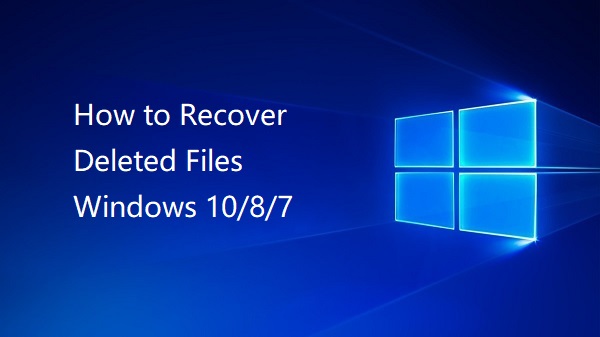
Summary: There are several ways you can try to recover deleted files in Windows 11, 10, 8, and 7, even after the files are permanently deleted. If the deleted files are really important, undeleting files with a file recovery program gives you the best chance to get back the files.
We delete files on Windows computers all the time and sometimes, we deleted files or folders that we shouldn’t delete. When this happens, how to recover deleted files or folders in Windows? To be more specific, how to recover permanently deleted files?
This article will show you everything you need to know to recover deleted files in Windows 11, 10, 8, 7, XP, and Vista. You can recover deleted files that are not in Recycle Bin or even recover files that are permanently deleted by pressing the Shift + Delete keys.
The steps can be applied to recover deleted files on Acer, Asus, Dell, Lenovo, HP, Microsoft, Samsung, Toshiba, Google laptops, or desktop computers.
Can we recover permanently deleted files in Windows 11/10?
Yes. Deleted files in Windows 11/10/8/7 can be recovered. In fact, there are several methods you can try to get back deleted files in Windows 11/10/8/7.
First of all, on Windows PC, deleted files go to Recycle Bin if you simply click Delete. So Recycle Bin is the first place you should check for file recovery.
Secondly, we may have multiple copies of the same file on the computer. Before spending time and even money in recovering deleted files, open Windows File Explorer, input the name of the deleted file in the search bar, and see if an extra copy can be found.
Thirdly, Windows offers several file backup methods to avoid data loss, for instance, restoring deleted files from Windows backup, and restoring the files to the previous version. And many Windows 10 users store files in OneDrive, Dropbox, or other cloud services. Don’t forget to check your cloud storage for deleted files.
Finally, even in the worst case that your files are literally deleted and nowhere to be found, the permanently deleted files are actually recoverable with a data recovery program. The reason why we can undelete files in Windows 11, 10, 8, and 7 is that the deleted files still remain on your hard disk. Sound weird? It will make sense after you learn how files are stored in the Windows system.
A hard disk is divided into many storage cells, which are called sectors. When you create and edit a file on Windows PC, the content of the file is written into multiple sectors and a pointer is created in the system to record from which sector the file begins and where the file ends.

When you delete a file permanently, Windows deletes the pointer only, while the file data is still saved in the sectors of the hard disk. That’s why permanently deleted files can be recovered with a file recovery program.
However, you should know that the computer won’t keep the deleted files for a long time. After a pointer is deleted, Windows will mark the sectors that the deleted file occupies as free space, which means that any new file can be written into the sectors and overwrite the deleted file. Once the sectors are used by new files, the deleted file can’t be recovered anymore.
Therefore, to recover permanently deleted files in Windows 11/10/8/7, there are 3 rules to follow:
1. Use a file recovery program to retrieve the deleted files as soon as possible. The sooner the file recovery is done, the more likely the deleted data can be recovered.
2. Avoid using your computer after the files are deleted, especially not using the computer to download music, and videos, which can generate a large amount of new data on the hard drive and may potentially overwrite the deleted files. Close all programs and processes until the files are recovered.
3. Download and install a data recovery program on the drive that didn’t contain the deleted files. For example, if the files used to be on the C drive, download and install the program on the D or E drive.
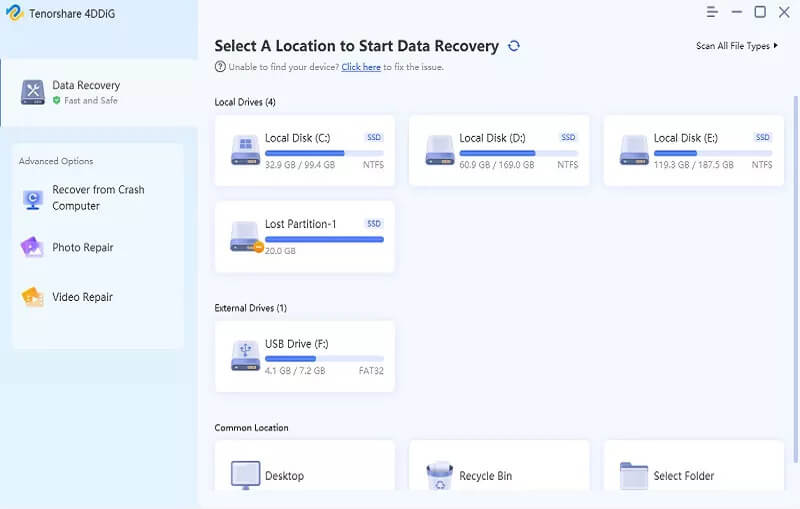
Bearing all the principles in mind, you can follow the steps below to restore deleted files on your Windows PC.
Recover permanently deleted Files & Folders in Windows 11/10
When a file is permanently deleted from Windows PC, hard drive, memory card, or other devices, the file actually is still in the memory except that the spot it occupies is marked as readable, which means new data can write in and use space. That’s why file recovery software can recover permanently deleted files, especially those are deleted recently.
Data Recovery is recommended to recover permanently deleted files on Windows 11, Windows 10, Windows 7, Windows 8, or Windows XP/Vista. It can recover deleted Word, Excel, PPT, or other files, photos, videos, audio files, and emails from Windows PC;
- Recover deleted files not only from desktop computer/laptop but also from a hard drive, SD card, flash drive, and others;
- Rescue files that are mistakenly deleted, lost after format, corrupted, or inaccessible due to system errors;
- Support data recovery from Windows 11, 10, 8, 7, XP, and Vista;
- Provide Deep Scanning and Quick Scanning to tackle data recovery in different situations;
- Allow preview of deleted files before recovering.
Now download Data Recovery to the drive that doesn’t contain deleted files and use it to find your deleted files.
Steps to Recover deleted files with Data Recovery
Step 1. Launch the program and select the type of files you want to recover. To recover deleted word/excel/ppt/pdf files in Windows, tick Documents; to recover deleted photos/videos from Windows, tick Photos, or Videos. Then tick the drive that used to contain the deleted files. Click Scan.

Step 2. The program will first quickly scan the chosen drive for the deleted files. Once the quick scan stops, search for the deleted files in the quick scan results. If the files have been deleted for some time, they usually cannot be found after a quick scan.

Step 3. Click Deep Scan to scan the Windows hard disk more thoroughly for the deleted files. This could take hours. So just keep the program running until the scan is finished.
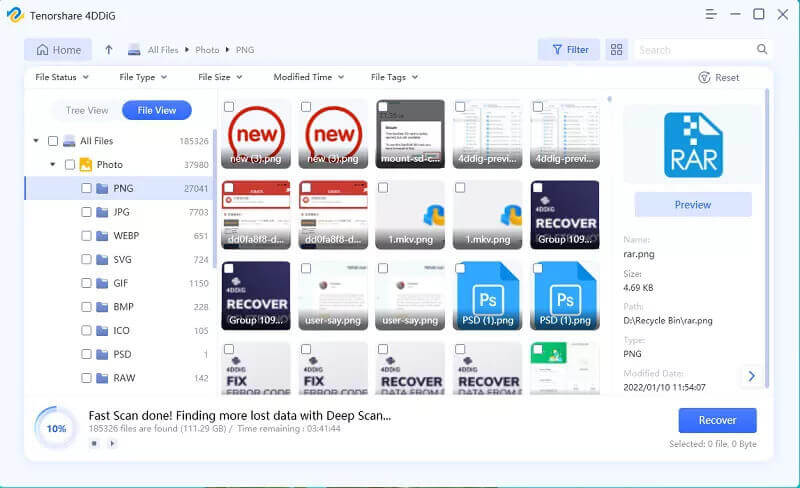
Step 4. Once you find the deleted files you need, click Recover to get them back to the location you choose.
Moreover, if you need to recover deleted files from an external drive, SD card, or digital camera, plug the device into your computer, and Data Recovery will retrieve the deleted data from the connected devices.
Find deleted files on Windows 11/10 via File Explorer
When you can’t find a file on the computer, instead of jumping to the conclusion that the file is deleted and gone, search for the lost file via Windows File Explorer and you may be surprised.
- Open File Explorer;
- Click My PC;
- Input a keyword of the file name into the search bar and click Enter;
- The search could take a while. Find the deleted file in the search result.

If the lost file doesn’t appear in File Explorer, it is probably deleted so your next step should be restoring the deleted file from Recycle Bin.
Recover deleted files on Windows 11/10 from Recycle Bin
We usually delete files by dragging them to Recycle Bin or right-clicking to delete them. In both cases, the deleted files are moved to Recycle Bin. So long as you didn’t delete the files from Recycle Bin or empty Recycle Bin, the deleted files can be restored from Recycle Bin easily.
The only exception is that when Recycle Bin runs out of the allocated disk space, the files that are deleted a long time ago will be erased automatically to free up space. To restore deleted files on Windows 11, 10, 8, 7, XP, and Vista:
- Open Recycle Bin;
- To quickly access the deleted files that you need, enter the keyword of file names to filter the deleted files. Or sort the deleted files by Name, Date Deleted, Item Type, etc.;
- Right-click the deleted files and select Restore. The deleted files will be put back to their original location.

If the deleted files can’t be found in either File Explorer or Recycle Bin, the files are deleted permanently. But luckily, you can recover permanently deleted files on Windows with or without software. If you have made a backup in Windows or created a restore point in the past, you can recover the deleted files without software. Otherwise, you need a data recovery program to get back the deleted files.
Restore deleted files from the Windows backup
If you have backed up your files with Windows’ built-in backup utility at some point, here is how you can restore the deleted files from the backup. Windows backup is available on Windows 11, 10, 8, and 7.
- Click the Start menu. Navigate to Windows System > Control Panel;
- Click Backup and Restore;
- If you have any backup available, you will have the Restore my files option in the Restore section;
- Click Restore my files and follow the on-screen instruction to recover your deleted files;

Retrieve deleted files/folders on Windows 11/10 via System Restore
If the files are Shift deleted or emptied from the Recycle Bin, yet you don’t have any backup, there is still one thing you can try to recover permanently deleted files without software: restoring the folder to the previous version.
Note: The method below can’t guarantee that your files can be retrieved. If the deleted files are really important to you, use a file recovery program, which has a better chance of recovering permanently deleted files.
Many of you may not be very familiar with a feature called “Restore Previous Version” in the Windows system, but this feature can be extremely helpful when it comes to recovering permanently deleted files on Windows without backup. The steps to restore a deleted file or folder from the previous version are very simple.
Step 1. Go to the folder that used to contain the deleted file or folder. Right-click the folder and choose to Restore previous versions from the drop-down list.
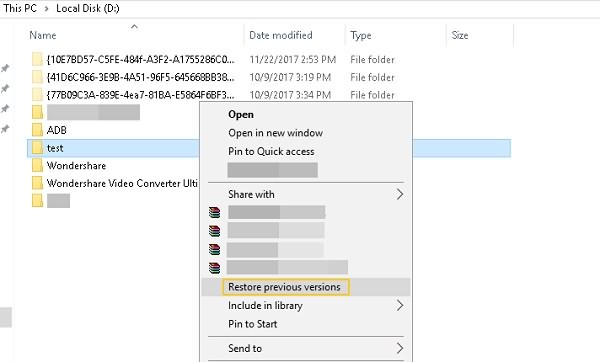
Tip: If you cannot remember in which folder the deleted files are saved, you can choose the drive that used to contain the file or folder. For example, right-click C drive and click Restore previous versions.
Step 2. A list of the available previous version of the folder will appear. Double-click the one created before the file is deleted, which will open the folder.
Step 3. Find the deleted file or folder you need and drag it to the desktop or another folder.
However, some of you may find that when clicking Restore’s previous version, the computer show: there are no previous versions available. That’s because you never create a restore point before. To create a restore point on Windows, you have to enable System Protection on Control Panel > System > System Protection.

If you don’t have an available previous version of a folder or file to restore, no worries, you can use a file recovery program for Windows to restore the deleted files.
Tips: Avoid file loss in Windows 11/10
Although there is file recovery software that can recover permanently deleted files in Windows 11, 10, 8, and 7, it is better to avoid data loss in the first place. Here are some tips you may find useful.
Back up your files on Windows. Backup is the best strategy to avoid data loss. Making an extra copy of the important files on your computer to an external hard drive, cloud service is one way to go. Also, create a Windows backup or enable System Restore on your PC.
Allocate more disk space to Recycle Bin. If there is enough disk space on your computer, you may consider giving more disk space to Recycle Bin. Windows will automatically erase deleted files from Recycle Bin when the allocated disk space for Recycle Bin is used up. With more space for Recycle Bin, there is a bigger chance that the files deleted a long time ago still can be undeleted from Recycle Bin.
- Right-click the Recycle Bin and select Properties;
- Under the General tab, select Custom size;
- Enter a larger size in the box and click OK.
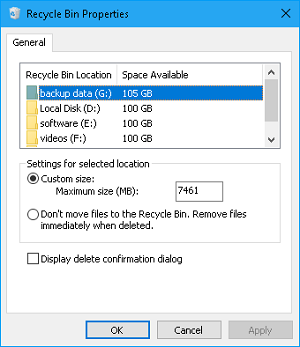
If there is any question about file recovery for Windows 11, 10, 8, or 7, leave your question below.
How useful was this post?
Click on a star to rate it!
Average rating / 5. Vote count:




